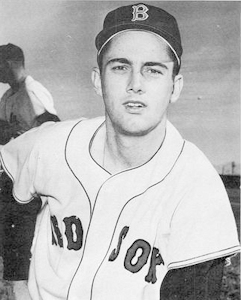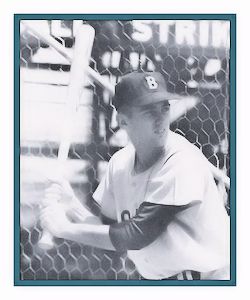|
“FENWAY'S BEST PLAYERS”  |
|||||
Two Long Islanders joined the Boston Red Sox in 1961: Carl Yastrzemski and Chuck Schilling. It was Schilling, a second baseman, who won the team’s MVP award that year. Of course, Yaz went on to become a Hall of Famer and one of the most celebrated Red Sox ever, whereas Schilling’s big-league career ended after 1965. Yet Yaz didn’t get any votes for 1961 AL Rookie of the Year, whereas Schilling’s first season was also good enough to tie him for third place behind another teammate, Don Schwall. As leadoff man, his offense compared quite well to the output of Yastrzemski, whose bat was cool for much of the year, and he also brought his main asset, slick fielding. Schilling was right-handed, stood 5-feet-10, and was listed at 160 pounds. He was born in Brooklyn, New York on October 25, 1937, the son of Charles and Theresa Schilling. In his younger days, his father pitched semipro for the Oneidas of Brooklyn, had a tryout with the Giants, and later pitched in Queens Alliance baseball.3 Chuck attended St. Mary’s High School in Manhasset, where he was MVP of the baseball team in his senior year. He graduated in 1955. He’d played sandlot ball for the New Hyde Park Hawks and CYO baseball. Schilling attended Manhattan College, majoring in electrical engineering but then switching over to mechanical engineering. In September 1958, while still in college, Schilling signed a bonus contract with Red Sox scout Frank “Bots” Nekola for a reported $25,000. Nekola, who lived in Long Island too added Yastrzemski after Schilling. His first assignment was in 1959 with Raleigh in the Class-B Carolina League, where he appeared in 14 games and was batting .275, but the decision was made to have him drop down to a lower classification. He was sent to Texas, where he played for the Alpine Cowboys in the Class-D Sophomore League. In 95 games, Schilling hit .340 and drove in 90 runs while scoring 111. In 1960 he spent the full season with the Minneapolis Millers, batting .314. He received the “personal endorsement” of future Hall of Fame second baseman Bobby Doerr. That meant a lot. Through most of the 1950s, the Red Sox had struggled to find a second baseman who could handle the position since Doerr had retired. Before he could join the Red Sox, however, Schilling had to squeeze in an obligation to the United States Army. He served six months of active duty from October 1960 to March 1961. He was released from Fort Devens, in Massachusetts, and reported to Scottsdale for Red Sox spring training on March 7th. There was a lot of hope placed on Schilling. The Sox second baseman in 1960 had been Pete Runnels, and he was the American League batting champion, but he wasn’t seen as an adequate fielder. Runnels was shifted to first base (and won another batting title in 1962). Manager Mike Higgins used Schilling as leadoff batter. Higgins valued him for his defense. He apparently told Schilling he could hit .087 and stick with the Sox. The only real concern was that Schilling might be too frail, that he might “lack the physical durability” and stamina to compete on a regular basis. He made the team and went 2-for-4 on Opening Day, with two singles, one on a bunt. He hit safely in his first three games, but collected his first RBI only in the fourth game, when he went 0-for-4 but an eighth-inning groundout drove in his double-play partner that day, Pumpsie Green. On May 7th, at Metropolitan Stadium in Minneapolis, Schilling had what he considered to be “my greatest day. And with good cause. In the top of the fourth inning, the Twins held a 3-2 lead when Schilling came up with the bases loaded, facing Camilo Pascual. He hit his first homer in the majors, to deep left field, about a dozen rows into the seats. The grand slam gave Boston a 6-3 lead. Later in the game, in the top of the eighth, with the Red Sox up by just one run, 8-7, Schilling doubled in two more runs off Don Lee. It was enough insurance to win the game (the final score was 11-9). In Schilling’s rookie year, his .991 fielding percentage led all second basemen. Several newspapers of the day cited it as a new record for fielding by a second baseman. What’s more, Schilling’s offensive production in 1961 was comparable to that of Yastrzemski (who was usually his roommate on Red Sox road trips). His 62 RBIs weren’t far behind Yaz’s 80. Whereas Yaz hit .266, Schilling hit .259, but he got on base more (.340 to Yaz’s .324) and scored 87 runs to Yastrzemski’s 71. The 1961 Rookie of the Year voting also took place that month. Dick Howser placed second behind Schwall and Schilling was tied with Floyd Robinson of the White Sox for third. In December, the Boston baseball writers unanimously selected Schilling as the team’s MVP for 1961 – the first time any rookie had won that honor. The 1962 baseball season was a disappointment all the way around, however, and right from the start. Schilling was expecting more of himself. His .259 batting average in 1961 was a commendable average for a rookie with such defensive genius. He started off ice-cold, though, going hitless in his first 25 at-bats of the season. As late as May 22nd he had an average under .200. He showed signs of emerging from the slump; on May 29th, his sixth-inning homer broke a 5-5 tie and gave the Red Sox an 8-5 win over the Twins. But on June 8th, hitting .219, Schilling was hit by a Gary Bell pitch, breaking his left hand. It was a month before he returned. By season’s end, Schilling had appeared in 119 games, with a .230 batting average, 35 RBIs, and 48 runs scored. His defense was just about as good (.985) as in 1961. The Red Sox traded for Felix Mantilla in December, looking to add more power. However, Mantilla got into just 66 games in 1963, making a mere five starts at second base. Schilling remained Boston’s starter there, appearing in 146 games. Schilling started the 1963 season strongly, and had two four-hit days (April 27 and May 1). He was batting .311 on June 1st, and everything was looking rosy. On June 11th, Schilling was playing in a 15-inning game against the Tigers in Detroit. The Red Sox won, 7-3, with four unanswered runs in the top of the 15th. Schilling’s run was the one that made the difference. After hitting over .300 for the first couple of months, Schilling’s batting average tailed off. He finished at .234, a minimal improvement over 1962’s .230. Despite 174 more plate appearances, he drove in two fewer runs (33). He scored 63 times. However, he precisely matched his .985 fielding percentage of the prior year. The Red Sox finished in seventh place, up one from 1962’s eighth-place finish, but the team went another direction in 1964, trading in a touch of defense for a little more offense. The primary second baseman was 20-year-old Dalton Jones, with Felix Mantilla in 45 games and Schilling in 47. He hit .176 with just seven RBIs. Schilling was reduced to a utility role in 1965, but rebounded a bit, hitting .240 in 71 games (many just as a pinch-hitter). He drove in nine runs. Two of them came in back-to-back games in Detroit on April 30th and May 1st, when he pinch-hit and homered each time. It was reported to have been the 11th time in major-league history that a pinch-hitter had homered in consecutive plate appearances. Just as the 1966 season was getting underway, Schilling was traded (along with catcher Russ Nixon) to the defending world champion Minnesota Twins for a player to be named later and Dick Stigman. In a way, it was like going home. Initially, Schilling was excited, returning to a city where he had always played well, both for the Millers and as a visiting player for the Red Sox. He was also going to a team that was a recent winner, not one languishing deep in the second division. But when he learned that Twins manager Sam Mele wanted to send him to Triple-A, he elected to retire instead. Schilling took a position with the E&M Machine Co. in Farmingdale, Long Island, in which his father was a partner. The Mets invited him to spring training in 1967 but he declined. hE played competitive softball until he was almost 70 years old. Having never appeared in a game for the Twins, Schilling did indeed play his full major-league career with the Red Sox. His career totals: 541 games, a .239 batting average (.304 on-base percentage), 23 homers, 146 RBIs, 230 runs scored, and a lifetime .985 fielding percentage (37 errors in 2,522 chances).
|
|||||

